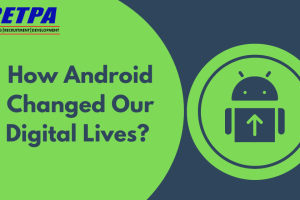All Your Android Development Questions – Answered

Android development is growing day by day and since there have been a lot of applications with more innovations coming up, it will automatically increase the demand of Android developers. Here, we have given a list of some interview questions that can help you.
Even when you join Android Development Training in Noida, then also you will be able to clear your concepts appropriately.
Android Development Interview Questions:
- List all the languages used to build Android.
There are multiple popular programming languages used while building Android application:
- Java: Java is a popular programming language that must be known by developers who are into the Android Development field. There are different IDE’s used by developers such as Netbeans, Eclipse, IntelliJ that have been used to build Android applications using Java.
- Kotlin: Kotlin is another cross-platform programming language that is new in the market and is safe and secure to develop an application using Android.
- Python: Python is another programming language that is dynamic and object-oriented and can connect with other technologies such as Machine learning.
- C#: It is a high-level programming language that is developed by Microsoft and runs on the .Net framework. Visual Studio is another IDE used for developing application while using C#
- A developer must know these languages and some other languages such as C++, HTML, C4droid, AIDDE, and others.
Explain the Android Application Architecture
Android Application Architecture is basically a software stack of components that has been used to support mobile device needs. There are several main components of Android Architecture that are:
- Applications: It is a top layer component that concludes third-party applications such as contacts, email, gallery, games, music, clock, and others. It runs within the Android runtime using classes and services from the application framework.
- Android Framework: It uses classes to create Android applications and provides generic abstraction for hardware access and managing UI and application resources. It provides services to create a particular class and make it helpful.
- Android Runtime: It is a backbone of Android that contains components like core libraries and Dalvik Virtual Machine (DVK). The Android runtime is the engine that powers our applications along with libraries.
- Platform Libraries: This basically includes C/C++ core libraries as well as java libraries such as SQLite, Graphics, SSL, OpenGS, and others.
- Linux Kernel: It is present at the bottom and is the heart of Android application architecture that manages all the drivers such as display drivers, Bluetooth drivers, audio drivers, memory drivers, and others.
Are you interested in Learning Android?
If yes, then honestly it is the best decision for your career as there will be multiple opportunities coming up in the future for Android Developers. To learn Android, you must first join the Android Development Certification Course from one of the best institutes, CETPA Infotech in Delhi NCR. They have been providing education for the last 20 years and provide the best training with the help of industry experts.
What is the APK Format?
APK format stands for Android packaging key. It is basically a compressed key with classes, UI’s, supportive assets, and manifest. All files are compressed in a single file that is known as APK.
What is ANR? Explain some reason to avoid ANR.
ANR stands for Application Not Responding. It is basically a dialog box that appears when an application is no longer responding. Some measures we can take to avoid ANR are:
- To avoid it, an application should perform a lengthy database or network operations.
- For background applications, you can relieve pressure from UI thread by using Intent Service.
Briefly explain Life Cycle of Android.
The life cycle of an Android application can be summarized as follows:
- The application is first launched, triggering the `onCreate()` method.
- If the application becomes visible, the `onStart()` and `onResume()` methods are called.
- If the user interacts with the application, various methods such as `onPause()` and `onStop()` may be called.
- If the application is no longer needed or is closed, the `onDestroy()` method is called to release any resources used by the application.
During the lifetime of an application, it may also go through various states such as running in the background or being restarted due to configuration changes. It’s important for developers to understand the Android application lifecycle to properly manage resources and provide a good user experience.
Explain in detail about important files and folders to create a new Android application.
To create a new Android application, you typically need to create the following files and folders:
- `AndroidManifest.xml`: This file describes the various components of your application such as activities, services, broadcast receivers, and permissions.
- ‘res` folder: This folder contains various resources that your application uses such as layouts, images, strings, colors, and styles. It’s typically divided into subfolders for each resource type.
- `java` folder: This folder contains the Java source code for your application. It typically includes a main activity file that serves as the entry point to your application.
- `drawable` folder: This subfolder of the `res` folder contains image resources for your application.
- `layout` folder: This subfolder of the `res` folder contains layout resources that define the user interface of your application.
- `values` folder: This subfolder of the `res` folder contains various value resources such as strings, colors, and styles that are used throughout your application.
By creating and organizing these files and folders properly, you can effectively develop and manage your Android application.
What is AndroidManifest.xml?
AndroidManifest.xml file describes the various components of your application such as activities, services, broadcast receivers, and permissions.
Differentiate between a Fragment and an Activity?
In Android, an Activity is a single, focused screen that the user interacts with. It can be thought of as a window in a desktop application. Activities can contain multiple views, which can be used to build a user interface.
A Fragment, on the other hand, is a modular section of an Activity. It can be thought of as a reusable portion of the UI. Fragments can be combined to create a multi-pane user interface, which is useful for larger screens such as tablets.
The main differences between Fragment and Activity are:
- Lifecycle: Activity has its own lifecycle and Fragments are managed by the Activity’s lifecycle. Fragments can be added, removed, or replaced within an Activity during runtime.
- Reusability: Fragments are designed to be reusable components that can be added to multiple Activities. Activities cannot be added to other Activities.
- UI Management: An Activity can have multiple Fragments and manage them in different ways, whereas a Fragment can only manage its own UI components.
Overall, both Activity and Fragment are important building blocks in Android development and understanding their differences is crucial for creating effective and efficient user interfaces.
Also Read: 7 Reasons to choose android training in 2022
How Does Garbage Collector Work in Android?
The garbage collector in Android is responsible for automatically freeing up memory that is no longer being used by an application. It works by periodically scanning the memory heap for objects that are no longer being referenced by the application’s code.
When the garbage collector identifies an object that is no longer being used, it marks it as garbage and removes it from memory. This process is known as garbage collection.
The garbage collector runs automatically in the background and there is typically no need for developers to manually manage memory in Android. However, it’s important to be mindful of memory usage in your application, as excessive memory usage can lead to performance issues and even crashes.
Developers can also help the garbage collector by avoiding unnecessary object creation, using efficient data structures, and releasing references to objects when they are no longer needed. By doing so, they can help reduce the frequency and duration of garbage collection, which can lead to better performance and user experience.
What is Data Binding in Android?
The Data Binding library is a type of support library that works on binding the UI components in the infrastructure to data sources in the application. With this technique, it is possible to change an element in the data set.



